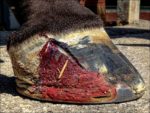Advertise Follow Us
Anatomy
Understand the pitfalls for better patching of performance horses
Read More
Reprinted with permission from Equine Veterinary Education (EVE). Original published in Equine Veterinary Education Vol 28 June 2016.
Various Aspects Of Barefoot Methodology Relevant To Farriery
This thorough review will help you analyze and plan for transitioning a horse from shod to barefoot
Read More
Forget Disciplines When Trimming
Florida farrier shares trimming, forging and knife sharpening tips at Anvil Brand clinic
Read More
Research Journal: September/October 2016
The information, ideas and opinions expressed are those of the author and do not necessarily represent those of the United States Department of Agriculture.
Read More
Keep Sport Horses On Solid Footing
How the hoof interacts with surfaces is critical for keeping horses sound
Read More







